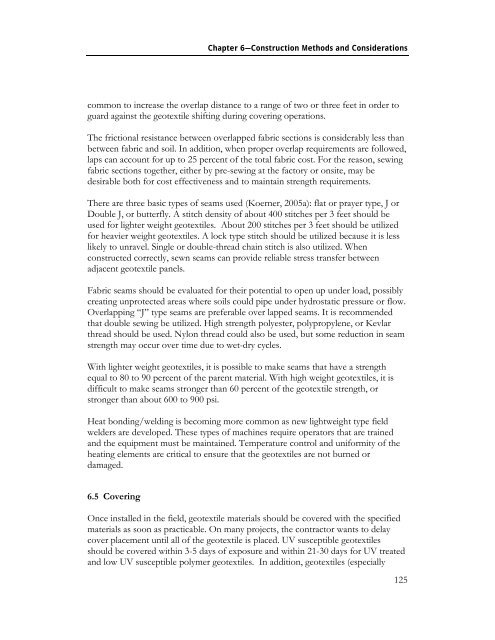Geotextiles in Embankment Dams - Association of State Dam Safety ...
Geotextiles in Embankment Dams - Association of State Dam Safety ...
Geotextiles in Embankment Dams - Association of State Dam Safety ...
You also want an ePaper? Increase the reach of your titles
YUMPU automatically turns print PDFs into web optimized ePapers that Google loves.
Chapter 6—Construction Methods and Considerationscommon to <strong>in</strong>crease the overlap distance to a range <strong>of</strong> two or three feet <strong>in</strong> order toguard aga<strong>in</strong>st the geotextile shift<strong>in</strong>g dur<strong>in</strong>g cover<strong>in</strong>g operations.The frictional resistance between overlapped fabric sections is considerably less thanbetween fabric and soil. In addition, when proper overlap requirements are followed,laps can account for up to 25 percent <strong>of</strong> the total fabric cost. For the reason, sew<strong>in</strong>gfabric sections together, either by pre-sew<strong>in</strong>g at the factory or onsite, may bedesirable both for cost effectiveness and to ma<strong>in</strong>ta<strong>in</strong> strength requirements.There are three basic types <strong>of</strong> seams used (Koerner, 2005a): flat or prayer type, J orDouble J, or butterfly. A stitch density <strong>of</strong> about 400 stitches per 3 feet should beused for lighter weight geotextiles. About 200 stitches per 3 feet should be utilizedfor heavier weight geotextiles. A lock type stitch should be utilized because it is lesslikely to unravel. S<strong>in</strong>gle or double-thread cha<strong>in</strong> stitch is also utilized. Whenconstructed correctly, sewn seams can provide reliable stress transfer betweenadjacent geotextile panels.Fabric seams should be evaluated for their potential to open up under load, possiblycreat<strong>in</strong>g unprotected areas where soils could pipe under hydrostatic pressure or flow.Overlapp<strong>in</strong>g “J” type seams are preferable over lapped seams. It is recommendedthat double sew<strong>in</strong>g be utilized. High strength polyester, polypropylene, or Kevlarthread should be used. Nylon thread could also be used, but some reduction <strong>in</strong> seamstrength may occur over time due to wet-dry cycles.With lighter weight geotextiles, it is possible to make seams that have a strengthequal to 80 to 90 percent <strong>of</strong> the parent material. With high weight geotextiles, it isdifficult to make seams stronger than 60 percent <strong>of</strong> the geotextile strength, orstronger than about 600 to 900 psi.Heat bond<strong>in</strong>g/weld<strong>in</strong>g is becom<strong>in</strong>g more common as new lightweight type fieldwelders are developed. These types <strong>of</strong> mach<strong>in</strong>es require operators that are tra<strong>in</strong>edand the equipment must be ma<strong>in</strong>ta<strong>in</strong>ed. Temperature control and uniformity <strong>of</strong> theheat<strong>in</strong>g elements are critical to ensure that the geotextiles are not burned ordamaged.6.5 Cover<strong>in</strong>gOnce <strong>in</strong>stalled <strong>in</strong> the field, geotextile materials should be covered with the specifiedmaterials as soon as practicable. On many projects, the contractor wants to delaycover placement until all <strong>of</strong> the geotextile is placed. UV susceptible geotextilesshould be covered with<strong>in</strong> 3-5 days <strong>of</strong> exposure and with<strong>in</strong> 21-30 days for UV treatedand low UV susceptible polymer geotextiles. In addition, geotextiles (especially125
















